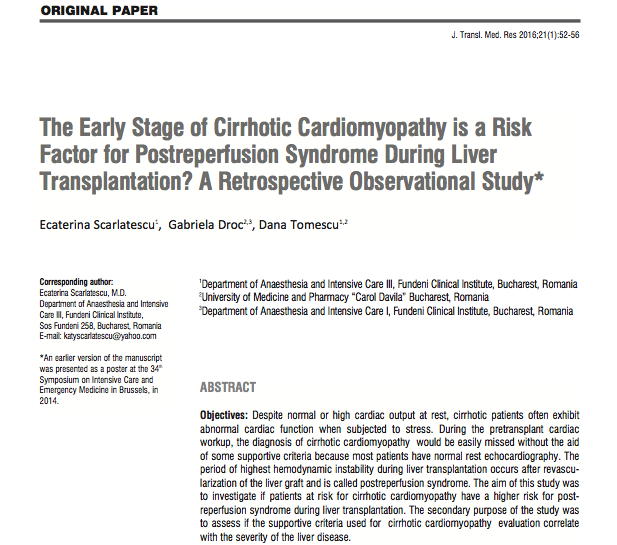Ecaterina Scarlatescu1, Gabriela Droc2,3, Dana Tomescu1,2
1Department of Anaesthesia and Intensive Care III, Fundeni Clinical Institute, Bucharest, Romania 2University of Medicine and Pharmacy “Carol Davila” Bucharest, Romania 3Department of Anaesthesia and Intensive Care I, Fundeni Clinical Institute, Bucharest, Romania
Rezumat:
Objectives: Despite normal or high cardiac output at rest, cirrhotic patients often exhibit abnormal cardiac function when subjected to stress. During the pretransplant cardiac workup, the diagnosis of cirrhotic cardiomyopathy would be easily missed without the aid of some supportive criteria because most patients have normal rest echocardiography. The period of highest hemodynamic instability during liver transplantation occurs after revascularization of the liver graft and is called postreperfusion syndrome. The aim of this study was to investigate if patients at risk for cirrhotic cardiomyopathy have a higher risk for postreperfusion syndrome during liver transplantation. The secondary purpose of the study was to assess if the supportive criteria used for cirrhotic cardiomyopathy evaluation correlate with the severity of the liver disease.
Material and Methods: The study group included 52 patients undergoing orthotopic liver transplantation for cirrhosis. The variables recorded were: demographic data, MELD and MELD Na scores, the length of the QT interval corrected for heart rate, plasma levels of brain natriuretic peptide (BNP), cold and warm ischemia times, vasopressor use, transfusional requirements and the occurrence of postreperfusion syndrome during transplantation.
Results: The patients were divided into 2 subgroups based on the occurrence of the postreperfusion syndrome. There was no statistically significant difference in BNP levels, length of QTc interval, MELD or MELD Na scores between the subgroups. BNP levels were correlated with QTc interval length (p=0.005), MELD and MELD Na scores (p=0.025 and p=0.001). The correlation between QTc interval length and the severity scores was not statistically significant.
Conclusions: Our study showed that postreperfusion syndrome was not correlated with the severity of the liver disease or with the presence of risk factors indicating cirrhotic cardiomyopathy. From the supportive criteria studied, only BNP levels correlate with the severity of the liver disease.
Material and Methods: The study group included 52 patients undergoing orthotopic liver transplantation for cirrhosis. The variables recorded were: demographic data, MELD and MELD Na scores, the length of the QT interval corrected for heart rate, plasma levels of brain natriuretic peptide (BNP), cold and warm ischemia times, vasopressor use, transfusional requirements and the occurrence of postreperfusion syndrome during transplantation.
Results: The patients were divided into 2 subgroups based on the occurrence of the postreperfusion syndrome. There was no statistically significant difference in BNP levels, length of QTc interval, MELD or MELD Na scores between the subgroups. BNP levels were correlated with QTc interval length (p=0.005), MELD and MELD Na scores (p=0.025 and p=0.001). The correlation between QTc interval length and the severity scores was not statistically significant.
Conclusions: Our study showed that postreperfusion syndrome was not correlated with the severity of the liver disease or with the presence of risk factors indicating cirrhotic cardiomyopathy. From the supportive criteria studied, only BNP levels correlate with the severity of the liver disease.
[gview file=”https://www.chirurgiehbp.ro/wp-content/uploads/2016/08/2016-1-52.pdf”]

